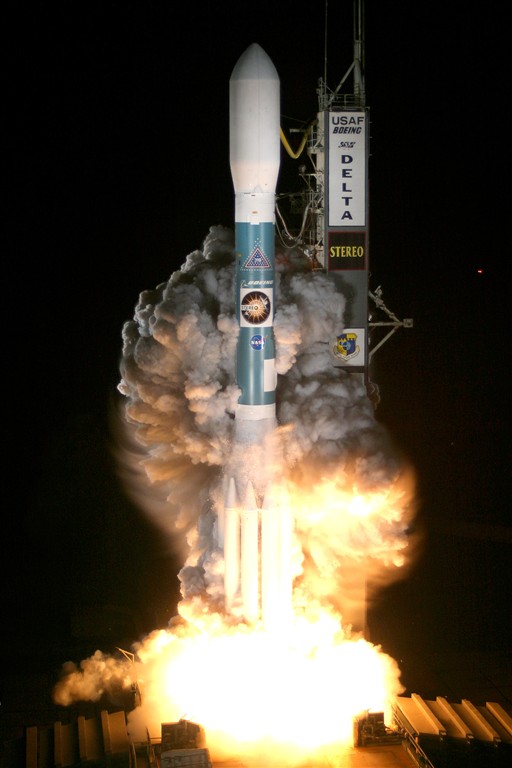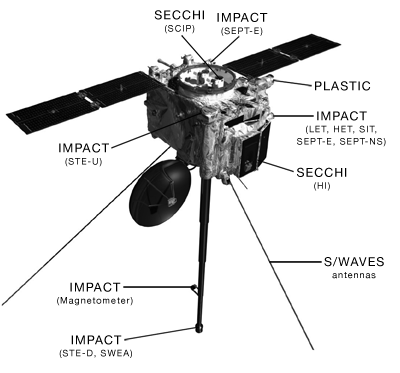STEREO
Solar Terrestrial Relations Observatory
What’s the big deal with the Sun?
 The Sun is not only the source of light and heat for the Earth, it also is the source of a kind of weather we call space weather. The Sun can produce HUGE explosions that release large amounts of light and material in violent events, solar flares and CMEs (Coronal Mass Ejections). When these events are directed towards the Earth they can have significant results. Most of us are familiar with the more beautiful side in the forms of Aurora, the Northern and Southern lights. But these events can also:
The Sun is not only the source of light and heat for the Earth, it also is the source of a kind of weather we call space weather. The Sun can produce HUGE explosions that release large amounts of light and material in violent events, solar flares and CMEs (Coronal Mass Ejections). When these events are directed towards the Earth they can have significant results. Most of us are familiar with the more beautiful side in the forms of Aurora, the Northern and Southern lights. But these events can also:
- Harm astronauts in spacecraft.
- Damage electronics on orbiting spacecraft.
- Create blackouts on Earth when they cause electrical surges in power grids.
Launched in October 2006, STEREO traces the flow of energy and matter from the sun to Earth. It also provides unique and revolutionary views of the sun-Earth system. STEREO, when paired with SDO, can now give us the first complete view of the sun’s entire surface and atmosphere.
CREDIT: NASA Goddard
Why STEREO?
The space weather events that travel from the Sun towards the Earth are the ones that have the most effect on our lives. Until now the missions that have studied these events have always looked at them head on. This has severally limited how completely we have been able to study and understand these events. We have always been limited to a single or monopic view. Now the STEREO mission has completely changed this and we will never see space weather quite the same. The two nearly identical spacecraft making up the STEREO mission were launched together in order to give us the first-ever stereoscopic view of the Sun and space weather events as they travel to the Earth and throughout the solar system.
What are STEREOs goals for understanding space weather?
- Understand the causes and mechanisms of coronal mass ejection (CME) initiation.
- Characterize the propagation of CMEs through the heliosphere.
- Discover the mechanisms and sites of energetic particle acceleration in the low corona and the interplanetary medium.
- Improve the determination of the structure of the ambient solar wind.
In order to achieve these goals, the two STEREO spacecraft were designed with 4 sets of instruments that look at CMEs from their source on the Sun following them as the propagate to the Earth and beyond. Before we go over the different instruments and what they do we will first mention the spacecraft launch.
STEREO Spacecraft Launch

The two spacecraft themselves are an engineering marvel. They are nearly identical twins. They were launched together on the same rocket, a Delta II, on Wednesday, October 25th, 2006 at 8:52 p.m. EDT from Cape Canaveral Air Force Station in Florida.
STEREO Instruments

As we mentioned above, there are 4 main goals of the STEREO mission but what they basically boil down to is answering the question: How do CMEs start and how do they get here? And to address these 4 main goals and answer this question, 4 different sets of instruments (instrument packages) were designed and built for the twin spacecraft.
http://stereo.gsfc.nasa.gov/instruments/instruments.shtml
These 4 instrument packages are:
SECCHI
The Sun-Earth Connection and Coronal and Heliospheric Investigation (SECCHI) is a suite of 5 scientific telescopes (EUVI, COR1, COR2, HI1 and HI2) that observes the solar corona and inner heliosphere from the surface of the Sun to the orbit of Earth. SECCHI is named after one of the first astrophysicists, Angelo Pietro Secchi (1818-1878). Angelo Secchi was a Jesuit priest and was one of the first astrophysicists to use the new medium of photography to record solar eclipses. He photographed the 1860 eclipse, during which a CME is now thought to have occurred.
SECCHI DETAILS »
SWAVES
STEREO WAVE (SWAVES) is an interplanetary radio burst tracker that traces the generation and evolution of traveling radio disturbances from the Sun to the orbit of Earth.
SWAVES DETAILS »
IMPACT
In-situ Measurements of Particles and CME Transients (IMPACT) samples the 3-D distribution and provides plasma characteristics of solar energetic particles and the local vector magnetic field. IMPACT is a suite of seven instruments, three of which are located on a 6-m deployable boom, with the others located on the main body of the spacecraft.
IMPACT DETAILS »
PLASTIC
The Plasma and SupraThermal Ion and Composition (PLASTIC) provides plasma characteristics of protons, alpha particles and heavy ions. This instrument provides key diagnostic measurements of the form of mass and charge state, and composition of heavy ions, and characterize the CME plasma from ambient coronal plasma.
PLASTIC DETAILS »
Launched ten years ago, on Oct. 25, 2006, the twin spacecraft of NASA’s STEREO mission – short for Solar and Terrestrial Relations Observatory – have given us unprecedented views of the sun, including the first-ever simultaneous view of the entire star at once. This kind of comprehensive data is key to understanding how the sun erupts with things like coronal mass ejections and energetic particles, as well as how those events move through space, sometimes impacting Earth and other worlds. Ten years ago, the twin STEREO spacecraft joined a fleet of NASA spacecraft monitoring the sun and its influence on Earth and space – and they provided a new and unique perspective.
The two STEREO observatories, called STEREO-A and STEREO-B – for Ahead and Behind, respectively – were sent out from Earth in opposite directions. Using gravitational assists from both the moon and Earth, the STEREO spacecraft were accelerated to Earth-escape velocities. STEREO-A was inserted into an orbit slightly smaller, and therefore faster, than Earth’s. For STEREO-B, the reverse happened: It was nudged into an orbit slightly larger than Earth’s so that it traveled around the sun more slowly, falling increasingly behind the Earth. As the spacecraft slowly fanned out away from the centerline between Earth and the sun – where every other sun-watching spacecraft is located – they revealed more and more new information about our closest star.
For STEREO’s 10th anniversary, Deputy Project Scientist Terry Kucera gives an overview of the missions top 5 success stories.
Credit: NASA’s Goddard Space Flight Center/Genna Duberstein
Music credit: Life Choices by Eric Chevalier

